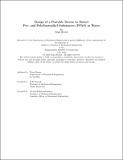Design of a Portable Device to Detect Per- and Polyfluoroalkyl Substances (PFAS) in Water
Author(s)
Benner, Tioga
DownloadThesis PDF (11.90Mb)
Advisor
Karnik, Rohit
Terms of use
Metadata
Show full item recordAbstract
PFAS or per- and polyfluoroalkyl substances are a group of man made chemicals used since the 1940s. The chemicals are highly stable and build up in the environment and organic systems. They can also cause several health problems in humans at high concentrations causing them to be a chemical of significant concern given their ubiquity. This article details the engineering research efforts in creating an initial design and prototype for a portable PFAS testing device to be used in the field for long term PFAS measurement of both drinking and groundwater. This research will also provide an initial validation and derisking for this PFAS measurement system and is intended to be used as a starting point for an eventual effort to create a marketable PFAS testing device by the project sponsor Xylem Corporation. The measurement of PFAS is made possible by a polymer developed by members of Tim Swager’s lab in MIT that has a fluorescence quenching response in the presence of PFAS.
Multiple initial concepts were created and rated on a variety of different factors to find a final fluidic system design that would be most effective for this use case. The final design uses a needle based system inserting microliter scale sample fluids into a cartridge of many single use microwells. The microwells are multilayered devices designed to not interact with PFAS that can be easily integrated together into a cartridge with more than a hundred individual microwells fitting in a single 25 X 25 mm2 sheet allowing many tests to be done before requiring manual replacement of the cartridge. The cartridges can be easily removed and replaced for ease of use in the field. This design simplifies production of the device, can be easily automated and can fit within a conventional backpack for easy transport fulfilling the goals set out by Xylem for the final device.
This article also discusses initial experiments into polymer validation showing potential methods of differentiating different types of PFAS and with tests of polymer sensitivity using fluorescence images. These experimens found limits of detection close to 0.1 ppb and there are multiple promising ideas to improve that sensitivity, which are being pursued through experimentation.
Date issued
2023-06Department
Massachusetts Institute of Technology. Department of Mechanical EngineeringPublisher
Massachusetts Institute of Technology